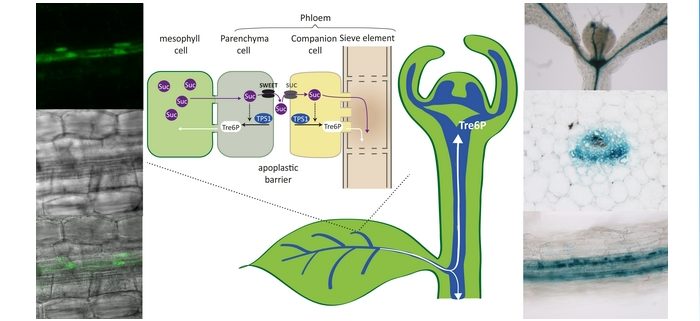TREHALOSE-6-PHOSPHATE SYNTHASE1 – an essential enzyme in Arabidopsis
Fichtner et al. transformed the embryo-lethal mutant tps1 with variants of the TPS1 gene to identify critical domains for function and localization of the gene product. The Plant Cell (2020) https://doi.org/10.1105/tpc.19.00837
By Franziska Fichtner1,2 and John Lunn1, 1Max Planck Institute of Molecular Plant Physiology, Potsdam-Golm, Germany; 2Current address: School of Biological Sciences, The University of Queensland, St. Lucia, Australia
Background: Trehalose 6-phosphate (Tre6P) is a signal metabolite that is sometimes referred to as “plant insulin” because of its role in regulating sucrose levels in plants. Sucrose is made in the leaves and transported around the plant in the phloem to supply carbon and energy to developing tissues. Tre6P regulates the production of sucrose in the leaves and signals how much sucrose is available for growth in developing tissues. Disruption of Tre6P signaling has dire consequences for the plant, affecting leaf and root growth, flowering and seed production. In Arabidopsis, Tre6P is made by TREHALOSE-6-PHOSPHATE SYNTHASE1 (TPS1), and tps1 mutants that lack TPS1 cannot produce viable seeds. Despite its importance, the functions and properties of this complex enzyme are poorly understood.
Question: We had three main questions: (1) where is TPS1 located in the plant and within individual cells? (2) why is TPS1 essential for seed development? and (3) what are the functions of the non-catalytic parts of the TPS1 protein?
Findings: By tagging the TPS1 protein, we found that it is located mainly in the cell nucleus and revealed where Tre6P is likely to be made in Arabidopsis plants – the phloem-loading zone and guard cells of leaves, the root vasculature and the shoot apical meristem. Expression of active forms of TPS1, or a bacterial TPS, allowed the tps1 mutant to develop viable seeds, showing that restoring Tre6P synthesis is necessary and sufficient to restore seed production. However, after germination, the rescued plants did not grow or flower normally if parts of the TPS1 protein had been modified or removed. Together, these results reveal the important role of TPS1 in regulation of sucrose metabolism and sucrose signaling, and tell us where to focus future investigations to understand how Tre6P signalling works in plants.
Next steps: The most important challenges in the future will be to understand how Tre6P signaling works in different parts of the plant, and how it is linked with other signaling processes to coordinate the growth and development of plants with their metabolic status and environment.
Franziska Fichtner et al. (2020). Functional features of TREHALOSE-6-PHOSPHATE SYNTHASE1 – an essential enzyme in Arabidopsis thaliana. Plant Cell DOI: https://doi.org/10.1105/tpc.19.00837




